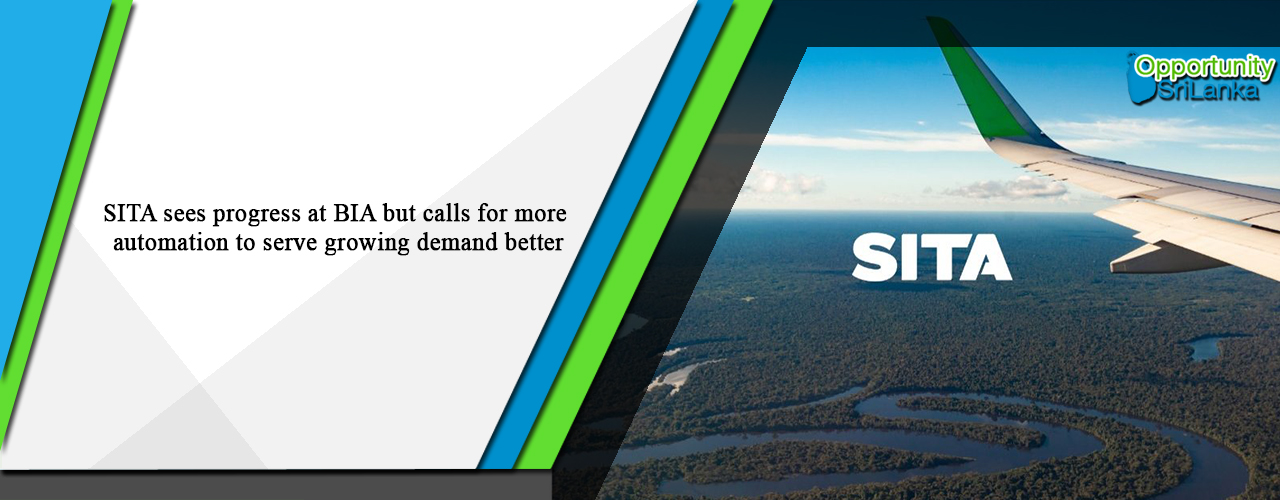SITA sees progress at BIA but calls for more automation to serve growing demand better
Daily FT: The global leader in technology solutions for the air transportation industry, SITA, has commended the progress at the Bandaranaike International Airport (BIA) amidst challenges and stressed for continuous investment in digital transformation to better manage the envisaged uptick in future traffic.
It acknowledged that the Sri Lankan authorities have implemented several recommendations made in a special SITA study on how to improve the passenger experience and operational efficiency. SITA officials whilst welcoming the progress stressed there is room for further improvement and the authorities are working on it.
SITA said BIA is in the process of adding 20 more self-service kiosks augmenting the existing eight at present and a self-bag drop unit. BIA uses CUTE solution comprising desktop, boarding pass printer, bag tag printers and gate readers at 59 check-in counters. SITA added that the BIA is also in the process of enabling global carriers to use the self-service kiosks option in a phased-out manner.
SITA which has been the leading technology partner for BIA since 1968, stressed acceleration of modernisation, automation and digital transformation is key as Sri Lanka plans to double the inflow of tourists in the next two years from 2024’s figure of 2 million.
“Sri Lanka is a tourism-dependent growth economy. Advancing digital travel solutions can play a key role in achieving this goal by enhancing the visitor experience and streamlining the travel process,” SITA Asia Pacific President Sumesh Patel told a media roundtable in Colombo yesterday.
According to SITA, the BIA saw a 16% growth in passenger traffic to 5 million in the first half of this year. Last year BIA saw 8.88 million passengers, up by 17.6% from 2023. Aircraft movements in 2024 rose by 20.7% with around 38 airlines operating at present. Sri Lanka is also on-course to add a second terminal in the next few years in addition to on-going expansion and modernisation. The number of passengers at BIA is forecast to increase to 14 million by 2027.
Patel said airlines and airports globally are investing in IT infrastructure, passenger processing and airport operations systems to future-proof their transformation. Airlines in 2024 invested $ 37 billion and airports invested $ 9 billion.
By 2027, as per SITA research, 75% of aviation industry stakeholders plan to adopt biometric-enabled technologies. Airports are also moving to cloud-based, mobile systems for check-in and boarding, cutting costs and improving flexibility. In the Asia Pacific, early use of API-driven platforms is boosting innovations and enabling digital, scalable passenger services beyond traditional infrastructure. At present over 1 billion e-passports are being used globally as well.
Owned by 400 global airlines and related industries, SITA has over 2,500 customers – almost every airline and airport in the world as well as governments, ground handlers and others. Specifically, SITA serves over 1,000 airports; and over 70 governments and all G20 nations use SITA’s border management solutions – representing 85% of all international air passengers. Over 13 billion air passengers benefit from SITA systems and over 2.2 billion traveller journeys a year are processed by SITA’s border solutions for over 660 airlines through a single gateway.
OSL take:
Sri Lanka’s ongoing development programme in line with the country’s target of becoming a hub in the South Asian region has resulted in the overall expansion in the digital industry due to the increasing demand for automation in all key economic sectors. The expansion and development of the BIA and the demand for automation all indicate the increasing business/investment opportunities in the fields of digital, technology and automation. With Sri Lanka becoming an emerging business destination in the South Asian region with the potential for further growth, the expansion in Sri Lanka’s digital industry including the fields of automation and technology will also witness a continuous growth. Given all these factors, foreign businesses/investors could confidently explore the expanding business/investment opportunities in Sri Lanka’s digital industry and related sectors.
| Article Code : | VBS/AT/20250917/Z_4 |

